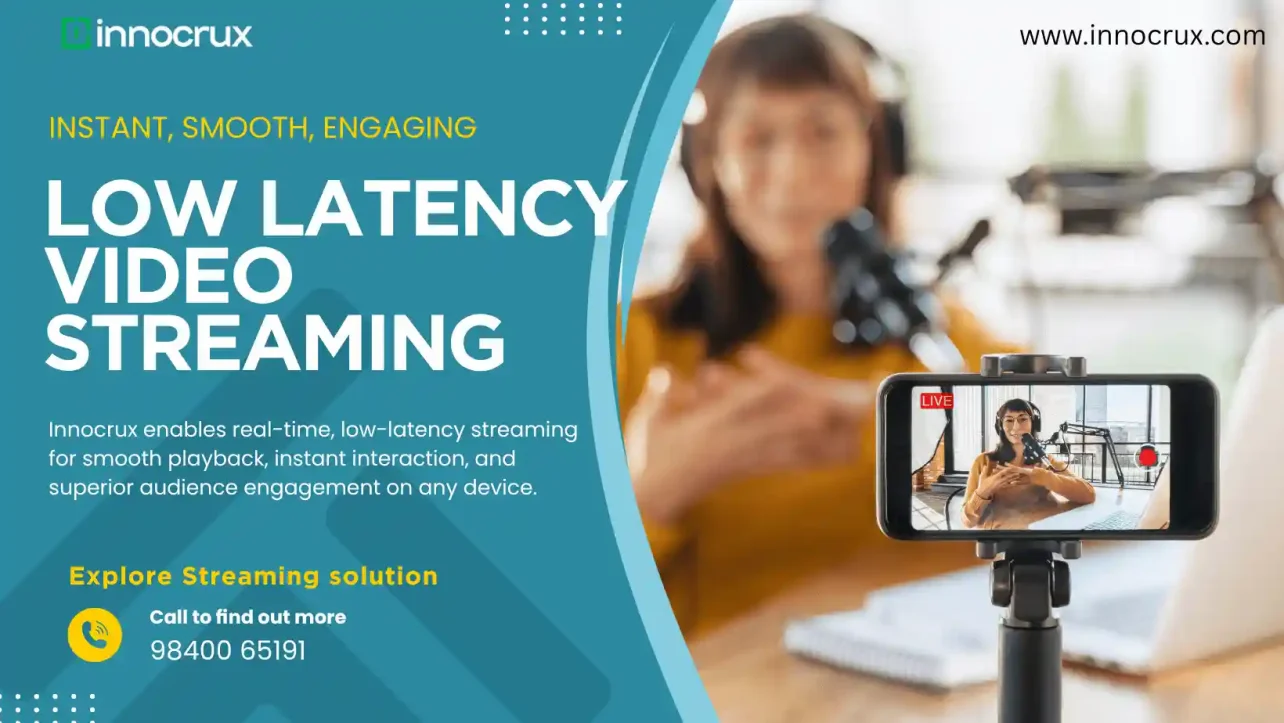Introduction to Low Latency Video Streaming
Low latency video streaming has transformed how audiences consume content worldwide. In today’s hyper-connected digital age, viewers expect real-time experiences that make them feel part of the action — whether it’s cheering for their favorite sports team, participating in a live auction, or interacting during an exclusive concert stream.”Low latency reduces the delay between when an event happens and when it’s viewed on-screen, providing instant engagement and immersive experiences.”This demand for immediacy pushes brands and content creators to innovate constantly. For businesses aiming to build OTT platforms, deliver video on demand (VOD) services, or host live events, adopting low latency streaming is essential to stand out, retain viewers, and maximize monetization opportunities. The ability to create a sense of “being there” is no longer optional — it’s the new standard.
Understanding Video Latency: How It Works
Video latency is the accumulated delay from the moment a camera captures footage to the instant it appears on a viewer’s device. It involves multiple stages: capturing, encoding, transmitting across networks, decoding, and final playback. Each step adds milliseconds that can add up to significant delays if not optimized”Research shows that viewers spend 10–20 times more time on live content than on-demand content, but only when latency is minimal and experiences are smooth.”In traditional broadcasting, higher latency could be tolerated since real-time interaction wasn’t expected. However, modern OTT streaming solutions, live sports broadcasts, and interactive online classes demand minimal latency to keep audiences engaged. Brands and creators looking to build a live streaming app or launch a live video streaming solution must carefully address latency to ensure high-quality, real-time viewing.
Key Challenges in Achieving Low Latency
Achieving true low latency video streaming is complex. The internet is inherently unpredictable, with varying bandwidth, different devices, and diverse regional connectivity affecting performance. Delivering consistent low latency globally requires advanced technological strategies and robust infrastructure.”Balancing high-resolution video quality with minimal delay is one of the most difficult challenges, as higher quality streams require more data and processing.”Additionally, coordinating global delivery through Content Delivery Networks (CDNs) without introducing extra latency is essential. Businesses exploring how to build OTT apps or seeking the best live streaming solutions for niche audiences — such as churches, educational institutions, or virtual fitness platforms — must find ways to overcome these hurdles to ensure a seamless, professional experience for every viewer.
Types of Latency in Streaming
Different types of latency exist, each impacting the overall viewing experience:
- Glass-to-glass latency: The total delay from the camera lens to the user’s screen. Critical for interactive streams like gaming, live auctions, and financial trading, this latency needs to be as low as possible, ideally under one second.
- Network latency: Caused by data transmission delays over the internet. Optimized routing, private CDNs, and edge computing are key to reducing this.
- Processing latency: The time taken for encoding and decoding video streams. Leveraging modern codecs and hardware acceleration can minimize this significantly.
If your business plans to build a live video streaming web application, develop a VOD platform, or create an IPTV OTT solution, optimizing each latency type is crucial for success.Reducing each element of latency not only improves technical performance but also enhances user satisfaction and engagement — ultimately boosting your brand’s reputation and revenue potential.
Technologies Enabling Low Latency Streaming
Thanks to technological advancements, several solutions now enable ultra low latency streaming at scale:
- WebRTC (Web Real-Time Communication): Ideal for peer-to-peer and interactive applications like video calls, online classrooms, and real-time event broadcasting.
- SRT (Secure Reliable Transport): Enhances reliability over unpredictable networks, making it an excellent choice for global live streaming.
- Low Latency HLS (LL-HLS): An improved version of Apple’s HLS, capable of delivering streams with just 2–3 seconds of delay while maintaining compatibility with large-scale audiences.
For any brand aiming to provide the best OTT streaming solution, integrating these technologies is critical to meet evolving audience expectations and outperform competitors.Moreover, hardware encoders, edge processing, and multi-CDN strategies ensure faster content delivery and help avoid bottlenecks, making your streams resilient and ultra-responsive worldwide.
Role of Adaptive Bitrate Streaming (ABR) in Reducing Latency
Adaptive Bitrate Streaming (ABR) is a vital component for delivering consistent, smooth video experiences. ABR works by creating multiple video renditions at different bitrates and resolutions, allowing the player to switch seamlessly based on the viewer’s network quality and device capability.This adaptive approach significantly reduces buffering and ensures playback continuity, even under fluctuating network conditions.For example, a live workout session viewed by participants around the world will still look crisp and stay in sync even if their internet speeds vary mid-session. ABR also plays a critical role in low latency live audio streaming, ensuring audio remains clear and accurately synchronized with the video feed. Businesses offering VOD solutions, live commerce, or looking to build live streaming apps depend on ABR to guarantee a professional-grade, reliable experience.
How Innocrux Ensures Seamless Low Latency Delivery
Innocrux stands at the forefront as a forward-thinking OTT solution provider with deep expertise in delivering low latency streaming at scale. Their platform combines advanced adaptive streaming, smart routing, and a global edge delivery infrastructure to achieve consistent, real-time experiences.”By leveraging private CDNs, intelligent transcoding, and dynamic ABR, Innocrux ensures audiences receive ultra low latency streams even during high-traffic peak events.”Innocrux’s solutions support ultra low latency video streaming protocols, secure content delivery, and real-time analytics — empowering businesses to focus on creating engaging content and growing their brand. Whether your goal is to build an OTT platform, create a live streaming website, or launch a fully integrated VOD platform, Innocrux offers customizable, white-label OTT solutions designed for scalability and monetization. Brands can implement various business models, including ad-based, subscription, or pay-per-view, while also benefiting from DRM support and advanced data insights.
Benefits of Low Latency Streaming for Businesses
Choosing low latency streaming unlocks a wide range of strategic advantages:
- Real-time engagement: Let audiences comment, interact, or shop live, dramatically increasing viewer participation and conversion rates.
- Enhanced brand loyalty: Viewers appreciate instant, uninterrupted experiences and are more likely to return and recommend your service.
- Diverse monetization opportunities: Enables innovative revenue streams like live shopping, dynamic ad insertion, and interactive sponsorships.
- Global scalability: With a strong OTT video solution and live video streaming solution, businesses can confidently expand into new markets without sacrificing quality.
- Flexible applications: From entertainment and sports to education, religious services, and live commerce, low latency creates countless possibilities.
Whether you’re building an OTT platform from scratch, creating a live streaming app, or deploying a VOD solution, low latency is essential to modern digital success and competitive advantage.
Low latency streaming isn’t just faster — it transforms viewers into active participants, creating unforgettable, real-time brand experiences.
Real-Time Analytics & Statistics
A major advantage of modern low latency streaming platforms is the power of real-time analytics and viewer statistics. Unlike traditional broadcasting, where feedback is delayed or vague, today’s OTT solutions offer detailed, instant insights into audience behavior.
With real-time analytics, brands can monitor viewer engagement, retention rates, geographic reach, and interactive metrics as they happen — allowing immediate adjustments and data-driven decision-making.
For example, if analytics show a drop in engagement during a live product demo, you can adjust content flow on the spot or push targeted on-screen offers to recapture interest. Statistics such as concurrent viewers, average watch time, interaction frequency, and quality-of-experience scores enable content owners to continuously optimize streams and improve ROI.
Popular chart types used to visualize these metrics include:
- Line graphs for tracking concurrent viewers over time.
- Heatmaps to show geographic distribution of viewers.
- Bar charts for comparing engagement across different segments or content types.
- Pie charts to represent device or platform distribution.

Example: Real-Time Viewers Line Chart (Code Snippet)
Here’s a simplified JavaScript (React + Chart.js) example showing how you might visualize concurrent viewers in real time:
jsx
import React, { useEffect, useState } from "react";
import { Line } from "react-chartjs-2";
import "chart.js/auto";
export default function ViewerAnalyticsChart() {
const [dataPoints, setDataPoints] = useState([]);
useEffect(() => {
// Simulate real-time data updates every 5 seconds
const interval = setInterval(() => {
setDataPoints((prev) => [
...prev,
{
time: new Date().toLocaleTimeString(),
viewers: Math.floor(Math.random() * 5000 + 500),
},
]);
}, 5000);
return () => clearInterval(interval);
}, []);
const chartData = {
labels: dataPoints.map((point) => point.time),
datasets: [
{
label: "Concurrent Viewers",
data: dataPoints.map((point) => point.viewers),
borderColor: "rgba(75,192,192,1)",
backgroundColor: "rgba(75,192,192,0.2)",
fill: true,
},
],
};
return <Line data={chartData} />;
}
Conclusion
Low latency video streaming is no longer a luxury; it is a business-critical necessity for building stronger, more interactive relationships with audiences.”With Innocrux as your OTT solution provider, you gain a robust, future-proof platform that empowers you to deliver ultra low latency live streaming, advanced VOD solutions, and immersive experiences worldwide.”Whether you’re looking to build an OTT platform, launch a new live streaming app, or scale your video on demand services, now is the time to adopt low latency streaming. By partnering with Innocrux, you ensure your brand stays ahead of the curve, delights audiences everywhere, and unlocks new revenue potential like never before.
Low latency enables businesses to foster stronger, more interactive relationships with their audiences. OTT solution providers can deliver ultra low latency live streaming and immersive VOD solutions which allow businesses to flexibly scale their global reach.
Now is the perfect opportunity to build an OTT platform, launch live streaming apps, or expand on-demand services through reduced video streaming latency. Partnering with Innocrux not only ensures industry stability but also improves audience satisfaction and revenue streams through advanced features like outstream dynamic ads.








No comments yet